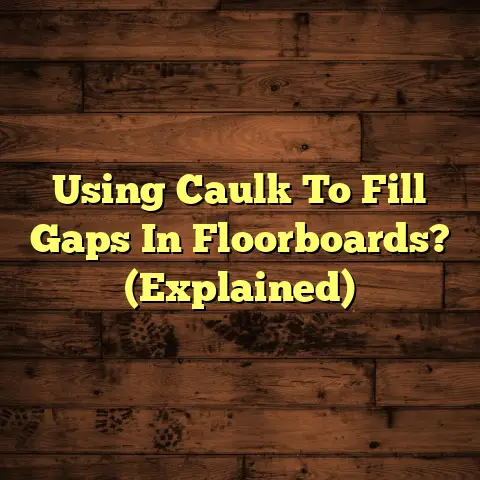Why is My Hardwood Buckling? (9 Causes Revealed!)
As a flooring contractor with years of experience, I’ve seen it all – from the stunning transformations hardwood floors can bring to a home, to the heartbreak when they start to buckle.
Hardwood flooring is like a chameleon; it can adapt
to almost any style you’re going for.
It adds warmth,
character, and a touch of elegance that’s hard to
beat.
But let’s be real, it’s not invincible.
Buckling is a common problem, and it can be
frustrating!
But trust me, understanding why it happens
is the first step to fixing it.
So, let’s dive into the
nine most common culprits behind hardwood buckling,
and how you can tackle them head-on!
1. Humidity and Moisture Levels: The Silent Culprit
Think of your hardwood floor as a sponge.
It’s constantly
absorbing moisture from the air around it.
When humidity
levels spike, especially during those muggy summer months,
your floorboards soak it up like crazy.
Wood is hygroscopic, meaning it naturally absorbs
and releases moisture to balance with its environment.
High humidity causes wood cells to swell, leading to
expansion.
If the expansion is constrained, the boards
can buckle upwards.
According to the Forest Products Laboratory,
wood can expand significantly with changes in
moisture content.
For example, a 3-inch wide
oak board can expand by as much as 1/8 inch
with a 6% increase in moisture content.
(Source: USDA Forest Service)
Seasonal changes can also wreak havoc.
Winter air
is typically drier, causing wood to shrink.
Then, when
spring rolls around with its increased humidity, the
wood expands again.
This constant cycle of expansion
and contraction puts stress on the flooring.
What can you do?
- Invest in a dehumidifier: Keep indoor humidity levels between 30-50%.
- Monitor humidity: Use a hygrometer to track the humidity in your home.
- Improve ventilation: Ensure good airflow, especially in bathrooms and kitchens.
2. Poor Installation Practices: Cutting Corners Can Cost You
I can’t stress this enough: proper installation is
everything!
It’s the foundation upon which your beautiful
hardwood floor stands.
If corners are cut during
installation, you’re setting yourself up for trouble.
One of the biggest mistakes I see is inadequate
acclimation.
Hardwood needs time to adjust to the
environment of your home before it’s installed.
This usually means leaving the wood in the room
for several days, or even weeks, to stabilize.
If you skip this step, the wood will continue to expand or contract after installation, leading to gaps, warping, and yes, buckling.
Another common error is incorrect nailing or stapling.
If the fasteners are too far apart or not driven in
at the right angle, the boards won’t be held securely
in place.
Expansion gaps are also crucial.
Hardwood needs room
to expand and contract with changes in humidity.
If there’s no gap around the perimeter of the room
or against fixed objects, the wood will have nowhere
to go and will buckle under the pressure.
My advice?
- Hire a professional: Don’t skimp on the
installation.
A qualified installer knows the tricks of the trade. - Ask questions: Make sure your installer understands the importance of acclimation and expansion gaps.
- Check references: Don’t be afraid to ask for references and see examples of their work.
3. Water Damage: The Unforgiving Foe
Water is hardwood’s worst enemy.
Whether it’s a
slow leak under the sink, a spilled glass of water
that wasn’t cleaned up immediately, or a full-blown
flood, water damage can cause serious problems.
Standing water and prolonged exposure cause the wood
to warp and buckle.
The water penetrates the wood
fibers, causing them to swell and distort.
If the
water sits long enough, it can even lead to rot and
mold growth.
I remember one client who had a dishwasher leak.
They didn’t notice it for a few days, and by the
time they did, the hardwood floor in their kitchen
was completely ruined.
The boards were cupped,
buckled, and starting to rot.
It was a costly
repair.
Be proactive!
- Fix leaks immediately: Don’t let a small leak turn into a big problem.
- Clean up spills promptly: Wipe up any spills as soon as they happen.
- Check appliances regularly: Inspect your dishwasher, washing machine, and refrigerator for leaks.
4. Subfloor Issues: The Hidden Foundation
The subfloor is the unsung hero of your hardwood floor.
It provides a stable, level surface for the hardwood
to rest on.
If the subfloor is uneven, has moisture
problems, or lacks proper support, it can cause the
hardwood to buckle.
Uneven surfaces can create stress points on the
hardwood, causing it to flex and eventually buckle.
Moisture intrusion from below can also lead to
warping and buckling.
And if the subfloor isn’t
strong enough to support the weight of the hardwood,
it can sag and cause the flooring to buckle.
Look out for these signs:
- Soft spots: Areas of the floor that feel spongy or give way when you step on them.
- Visible cracks: Cracks in the subfloor can indicate structural problems.
- Musty odor: A musty smell can be a sign of moisture and mold growth.
What to do:
- Inspect the subfloor: Before installing hardwood, make sure the subfloor is level, dry, and structurally sound.
- Repair any problems: Fix any cracks, uneven spots, or moisture issues before laying the hardwood.
- Consider a moisture barrier: Install a moisture barrier between the subfloor and the hardwood to protect against moisture intrusion.
5. Temperature Fluctuations: The Roller Coaster Ride
Just like humidity, temperature changes can also affect
hardwood flooring.
Wood expands when it gets warmer
and contracts when it gets colder.
If these temperature
fluctuations are extreme or happen rapidly, it can
cause the wood to buckle.
Think about it: in the summer, your home might be
blasting with air conditioning, keeping the temperature
nice and cool.
But in the winter, you might crank up
the heat, causing the temperature to rise significantly.
This constant back-and-forth can put a lot of stress
on your hardwood.
Different types of hardwood react differently to
temperature changes.
Some species are more stable
than others.
For example, engineered hardwood is
generally more stable than solid hardwood because
it’s less susceptible to expansion and contraction.
Keep it steady!
- Maintain a consistent indoor climate: Avoid extreme temperature fluctuations.
- Use a programmable thermostat: Set your thermostat to maintain a consistent temperature throughout the day and night.
- Consider engineered hardwood: If you live in an area with extreme temperature changes, engineered hardwood might be a better choice.
6. Inadequate Maintenance: Neglect Can Lead to Disaster
Hardwood floors are beautiful, but they require
regular maintenance to keep them looking their best.
Neglecting routine cleaning, refinishing, and minor
repairs can contribute to buckling.
Dirt, dust, and grime can scratch and damage the
finish of your hardwood floor, making it more
susceptible to moisture damage.
Over time, the
finish can wear away completely, leaving the wood
exposed.
I had a client who never cleaned their hardwood
floors.
They just let the dirt and grime build up.
Eventually, the finish wore away, and the wood
started to absorb moisture.
The floors buckled and
had to be replaced.
Show your floors some love!
- Clean regularly: Sweep or vacuum your hardwood floors regularly to remove dirt and debris.
- Use a damp mop: Use a damp mop with a wood-floor cleaner to remove dirt and grime.
- Refinish when needed: Refinish your hardwood floors every few years to protect the wood and keep it looking its best.
7. Type of Hardwood: Not All Woods Are Created Equal
The type of hardwood you choose can also affect its
susceptibility to buckling.
Some species are more
stable and resistant to moisture than others.
Softwoods, like pine and fir, are generally less
dense and more porous than hardwoods, making them
more susceptible to moisture damage.
Hardwoods, like
oak, maple, and hickory, are denser and more resistant
to moisture.
Even within the hardwood category, there are differences
in stability.
For example, Brazilian cherry is known
for its stability, while beech is more prone to
movement.
Choose wisely!
- Consider the environment: Choose a hardwood species that is well-suited to your climate and lifestyle.
- Do your research: Learn about the different types of hardwood and their characteristics.
- Ask for advice: Talk to a flooring professional to get recommendations.
8. Heavy Furniture and Appliances: The Silent Pressures
Heavy furniture and appliances can cause localized
pressure on hardwood floors, potentially leading to
buckling.
The weight can compress the wood fibers,
especially if the weight is concentrated in a small area.
Think about your refrigerator, your sofa, or your
bookshelves.
These items can weigh hundreds of pounds,
and all that weight is being supported by a few small
points of contact with the floor.
Spread the load!
- Use protective pads: Place protective pads under the legs of heavy furniture and appliances to distribute the weight more evenly.
- Rearrange furniture: Periodically rearrange your furniture to avoid placing excessive pressure on the same areas of the floor.
- Consider area rugs: Place area rugs under heavy furniture to help distribute the weight.
9. Foundation Issues: The Root of the Problem
Finally, foundation problems can also lead to buckling
in hardwood floors.
If your foundation is settling,
cracking, or shifting, it can put stress on the
entire structure of your home, including the flooring.
A shifting foundation can cause the subfloor to become
uneven, which can then cause the hardwood to buckle.
Foundation cracks can also allow moisture to seep into
your home, which can damage the hardwood.
Don’t ignore the signs!
- Look for cracks: Check your foundation for cracks, especially around windows and doors.
- Check for sloping floors: Use a level to check for sloping floors, which can be a sign of foundation settlement.
- Inspect your basement: Look for signs of moisture in your basement, such as water stains or mold growth.
Call in the experts!
- Consult a foundation specialist: If you suspect you have foundation problems, consult a foundation specialist to get an inspection and recommendations for repairs.
Conclusion: Protecting Your Investment
So, there you have it – the nine most common causes
of hardwood buckling.
I hope this article has shed
some light on why your floors might be acting up.
Understanding these factors is crucial for maintaining
the beauty and functionality of your hardwood floors.
By taking proactive steps to address these issues, you
can prevent buckling and preserve the lasting appeal
of your custom hardwood flooring.
Remember, early detection and timely intervention
are key.
If you notice any signs of buckling, don’t
wait to take action.
The sooner you address the
problem, the less likely it is to cause serious damage.
And as always, if you’re not sure what to do, don’t
hesitate to call a professional.
A qualified flooring
contractor can help you diagnose the problem and
recommend the best course of action.
With a little knowledge and a little care, you can keep your hardwood floors looking beautiful for years to come!





